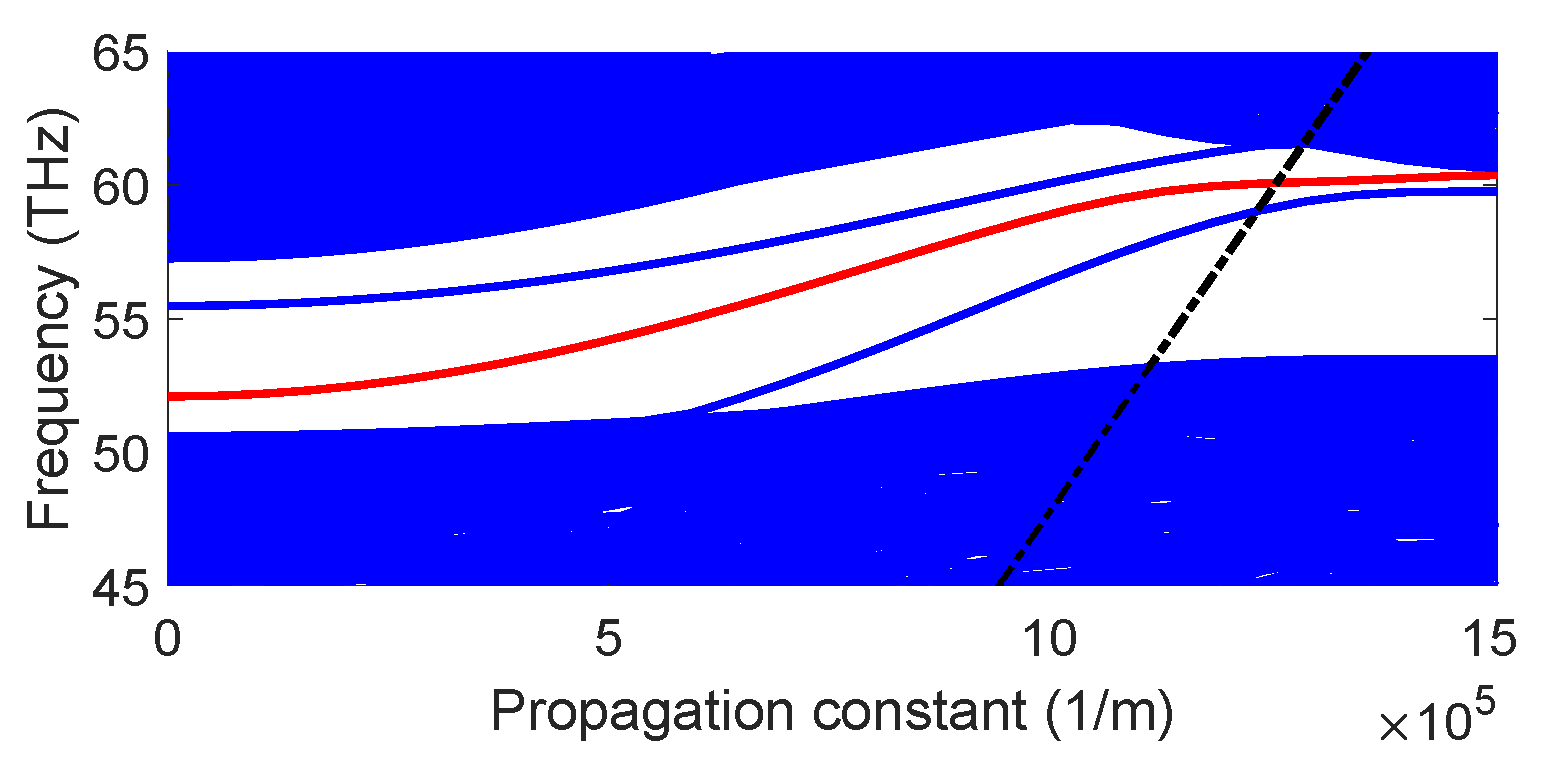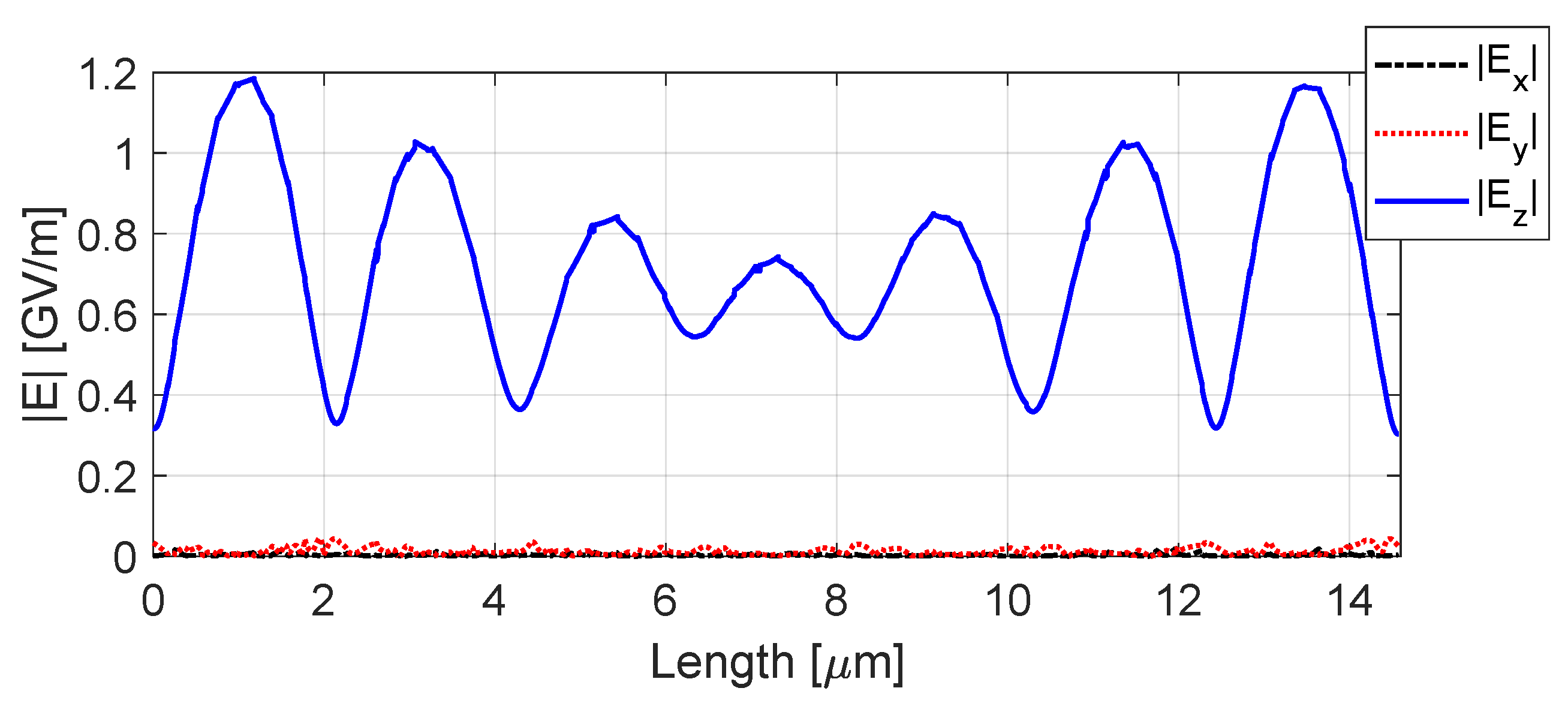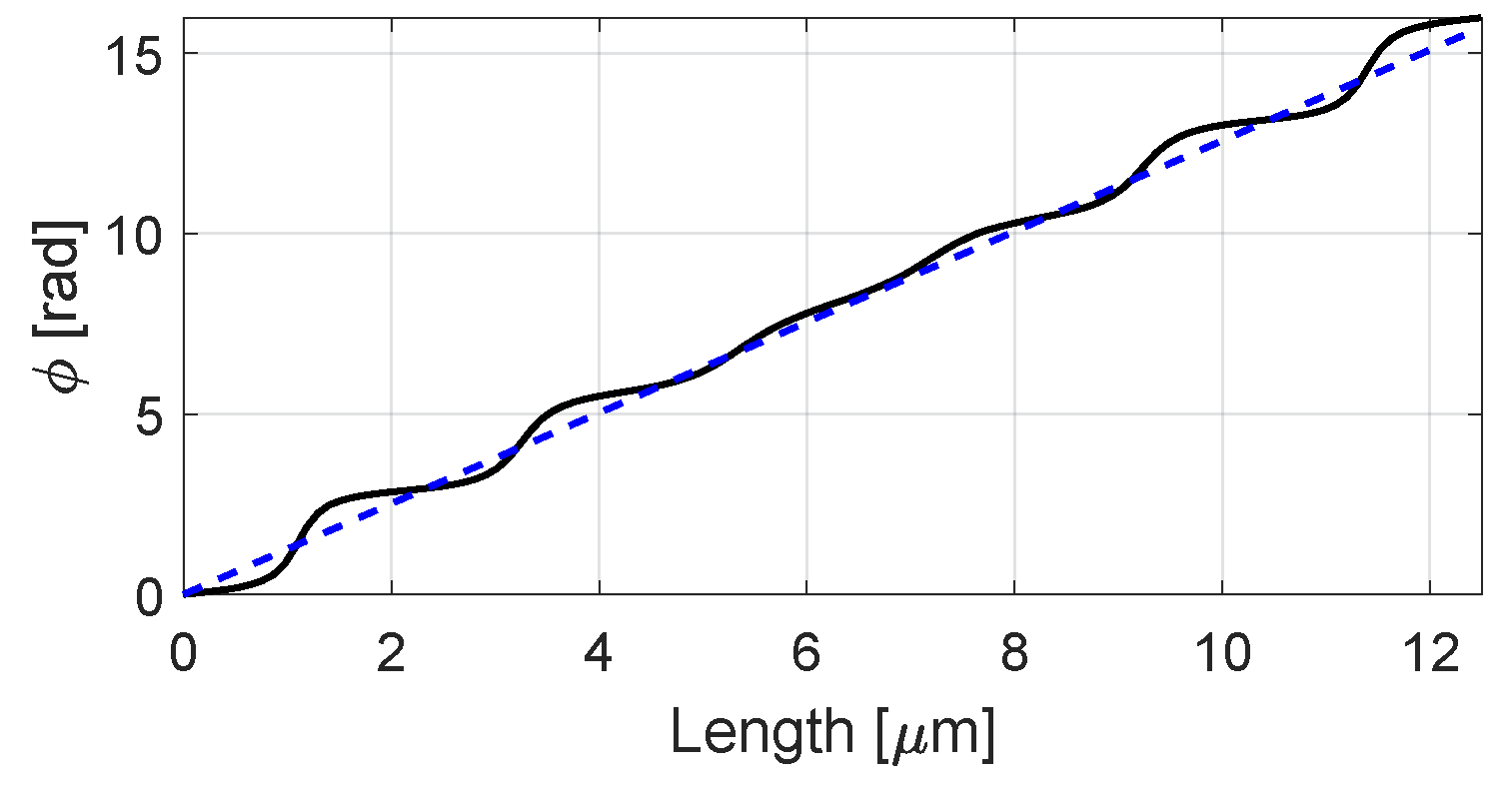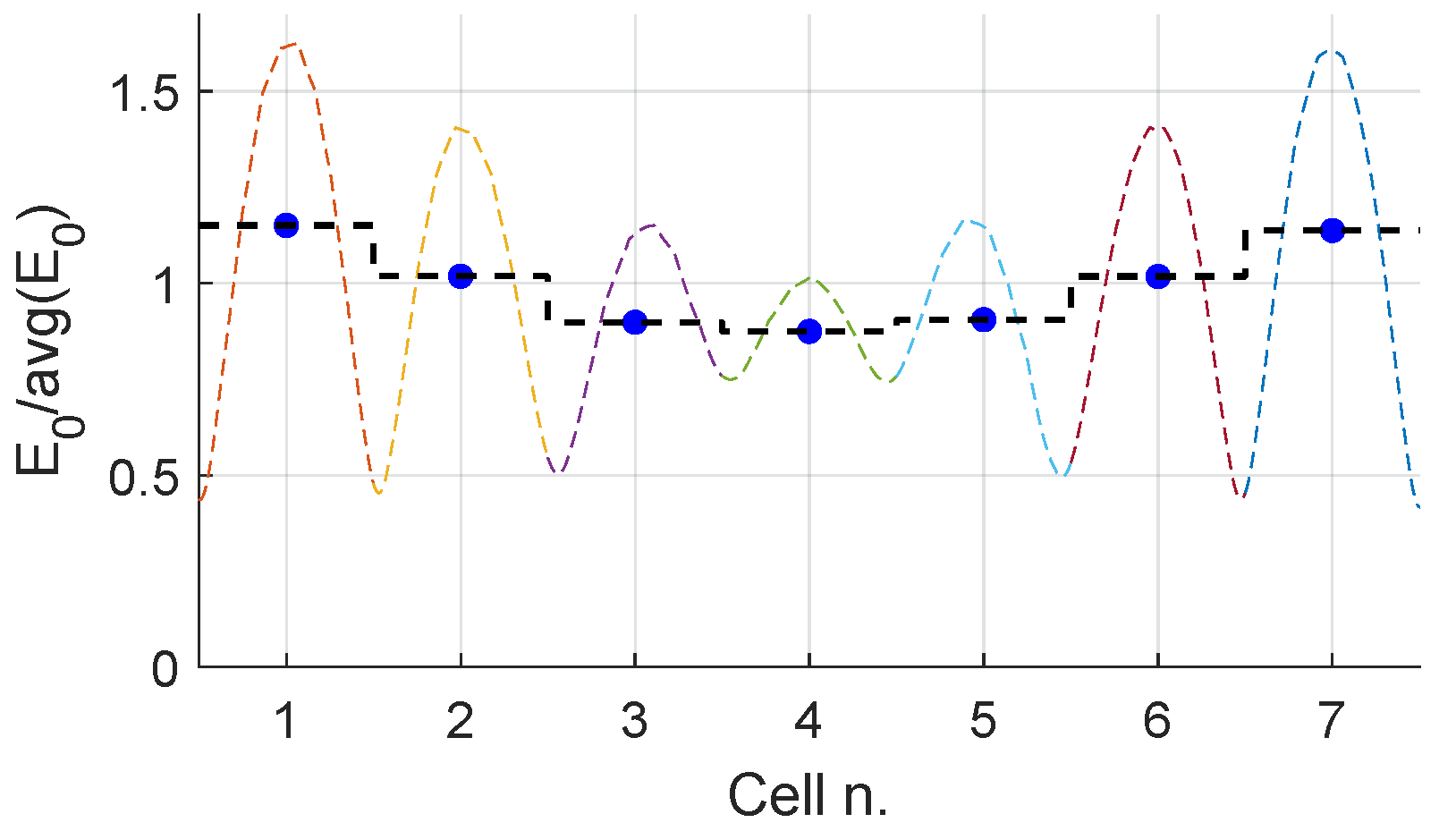Numerical Simulation of a Hollow-Core Woodpile-Based Mode Launcher for Dielectric Laser Accelerators
Abstract
:1. Introduction and Motivation
2. Hollow-Core Woodpile Coupler Design
3. Numerical Results
4. Figures of Merit
5. Conclusions and Perspectives
Author Contributions
Funding
Institutional Review Board Statement
Informed Consent Statement
Acknowledgments
Conflicts of Interest
References
- Engl, R.J.; Noble, R.J.; Bane, K.; Dowell, D.H.; Ng, C.K.; Spencer, J.E.; Tantawi, S.; Wu, Z.; Byer, R.L.; Peralta, E.; et al. Dielectric laser accelerators. Rev. Mod. Phys. 2014, 86, 1337–1389. [Google Scholar]
- Niedermayer, U.; Egenolf, T.; Boine-Frankenheim, O. Three Dimensional Alternating-Phase Focusing for Dielectric-Laser Electron Accelerators. Phys. Rev. Lett. 2020, 125, 164801. [Google Scholar] [CrossRef] [PubMed]
- Sapra, N.V.; Yang, K.Y.; Vercruysse, D.; Leedle, K.J.; Black, D.S.; England, R.J.; Su, L.; Trivedi, R.; Miao, Y.; Solgaard, O.; et al. On-chip integrated laser-driven particle accelerator. Science 2020, 367, 79–83. [Google Scholar] [CrossRef] [PubMed] [Green Version]
- Accelerator on a Chip International Program (ACHIP). Available online: https://achip.stanford.edu/ (accessed on 27 February 2022).
- Naranjo, B.; Valloni, A.; Putterman, S.; Rosenzweig, J.B. Stable Charged-Particle Acceleration and Focusing in a Laser Accelerator Using Spatial Harmonics. Phys. Rev. Lett. 2012, 109, 164803. [Google Scholar] [CrossRef] [PubMed]
- Joannopoulos, J.D.; Johnson, S.G.; Winn, J.N.; Meade, R.D. Photonic Crystals: Molding the Flow of Light, 2nd ed.; Princeton University Press: Princeton, NJ, USA, 2011. [Google Scholar]
- Hermatschweiler, M.; Ledermann, A.; Ozin, G.A.; Wegener, M.; von Freymann, G. Fabrication of silicon inverse woodpile photonic crystals. Adv. Funct. Mater. 2007, 17, 2273–2277. [Google Scholar] [CrossRef] [Green Version]
- Staude, I.; McGuinness, C.; Frölich, A.; Byer, R.L.; Colby, E.; Wegener, M. Waveguides in three-dimensional photonic bandgap materials for particle-accelerator on a chip architectures. Opt. Express 2012, 20, 5607–5612. [Google Scholar] [CrossRef] [PubMed]
- Wu, Z.; England, R.J.; Ng, C.K.; Cowan, B.; McGuinness, C.; Lee, C.; Qi, M.; Tantawi, S. Coupling power into accelerating mode of a three-dimensional silicon woodpile photonic band-gap waveguide. Phys. Rev. ST Accel. Beams 2014, 17, 081301. [Google Scholar] [CrossRef] [Green Version]
- Mauro, G.; Torrisi, G.; Mascali, D.; Sorbello, G.; Bacci, A.; Rossi, A.; De Angelis, C.; Locatelli, A. Numerical Simulation and Beam-Dynamics Study of a Hollow-Core Woodpile Coupler for Dielectric Laser Accelerators. In Proceedings of the 12th International Particle Accelerator Conference (IPAC’21), Campinas, Brazil, 24–28 May 2021; JACOW Publishing: Geneva, Switzerland, 2021; pp. 2022–2025. [Google Scholar] [CrossRef]
- Zhao, X.; Yuan, C.; Zhang, Q.; Zhao, L. Design and experiment study of compact circular-rectangular waveguide mode converter. Rev. Sci. Instrum. 2016, 87, 074707. [Google Scholar] [CrossRef] [PubMed]
- Alesini, D.; Citterio, A.; Campogiani, G.; Ficcadenti, L.; Migliorati, M.; Mostacci, A.; Palumbo, L.; Persichelli, S.; Zennaro, R. Tuning procedure for traveling wave structures and its application to the C-Band cavities for SPARC photo injector energy upgrade. J. Instrum. 2013, 8, P10010. [Google Scholar] [CrossRef]
- Johnson, S.G. MIT Photonics-Bands (MPB). Available online: http://ab-initio.mit.edu/photons/tutorial/ (accessed on 27 February 2022).
- Mauro, G.S.; Locatelli, A.; Torrisi, G.; Leonardi, O.; Celona, L.; De Angelis, C.; Sorbello, G. Fabrication and Characterization of Woodpile Waveguides for Microwave Injection in Ion Sources. IEEE Trans. Microw. Theory Tech. 2020, 68, 1621–1626. [Google Scholar] [CrossRef]
- Torrisi, G.; Locatelli, A.; Mauro, G.S.; Bellettato, M.; Celona, L.; Mancarella, F.; De Angelis, C.; Sorbello, G. Design and Characterization of a Silicon W-Band Woodpile Photonic Crystal Waveguide. IEEE Microw. Wirel. Compon. Lett. 2020, 30, 347–350. [Google Scholar] [CrossRef]
- Siemann, R. Energy efficiency of laser driven, structure based accelerators. Phys. Rev. Spec.-Top.-Accel. Beams 2004, 7, 061303. [Google Scholar] [CrossRef] [Green Version]
- Na, Y.N.; Siemann, R.; Byer, R. Energy efficiency of an intracavity coupled, laser-driven linear accelerator pumped by an external laser. Phys. Rev. Spec.-Top.-Accel. Beams 2005, 8, 031301. [Google Scholar] [CrossRef] [Green Version]
- Ansys HFSS; Ansoft Corp.: Pittsburgh, PA, USA, 2021.
- CST Microwave Studio. Dassault Systèmes; Vélizy-Villacoublay: Paris, France, 2021. [Google Scholar]
- Wangler, T.P. RF Linear Accelerators; Wiley-VCH, Verlag GmbH & Co. KGaA: Weinheim, Germany, 2008. [Google Scholar]
- Aloisio, M.; Sorbello, G. One-Third-of-Pitch Reduction Technique for the Analysis of Ternary Azimuthally Periodic Helical Slow-wave Structures. IEEE Trans. Electron Devices 2006, 53, 1467–1473. [Google Scholar] [CrossRef]
- Schachter, L.; Wilson, P.B. Beam-Wave Interaction in Periodic and Quasi-Periodic Structures. Physics Today 1998, 51, 90. [Google Scholar] [CrossRef]
- Mizrahi, A.; Schächter, L. Optical Bragg accelerators. Phys. Rev. E 2004, 70, 016505. [Google Scholar] [CrossRef] [PubMed] [Green Version]








Publisher’s Note: MDPI stays neutral with regard to jurisdictional claims in published maps and institutional affiliations. |
© 2022 by the authors. Licensee MDPI, Basel, Switzerland. This article is an open access article distributed under the terms and conditions of the Creative Commons Attribution (CC BY) license (https://creativecommons.org/licenses/by/4.0/).
Share and Cite
Mauro, G.S.; Torrisi, G.; Locatelli, A.; Bacci, A.; De Angelis, C.; Mascali, D.; Sorbello, G. Numerical Simulation of a Hollow-Core Woodpile-Based Mode Launcher for Dielectric Laser Accelerators. Appl. Sci. 2022, 12, 2609. https://doi.org/10.3390/app12052609
Mauro GS, Torrisi G, Locatelli A, Bacci A, De Angelis C, Mascali D, Sorbello G. Numerical Simulation of a Hollow-Core Woodpile-Based Mode Launcher for Dielectric Laser Accelerators. Applied Sciences. 2022; 12(5):2609. https://doi.org/10.3390/app12052609
Chicago/Turabian StyleMauro, Giorgio Sebastiano, Giuseppe Torrisi, Andrea Locatelli, Alberto Bacci, Costantino De Angelis, David Mascali, and Gino Sorbello. 2022. "Numerical Simulation of a Hollow-Core Woodpile-Based Mode Launcher for Dielectric Laser Accelerators" Applied Sciences 12, no. 5: 2609. https://doi.org/10.3390/app12052609
APA StyleMauro, G. S., Torrisi, G., Locatelli, A., Bacci, A., De Angelis, C., Mascali, D., & Sorbello, G. (2022). Numerical Simulation of a Hollow-Core Woodpile-Based Mode Launcher for Dielectric Laser Accelerators. Applied Sciences, 12(5), 2609. https://doi.org/10.3390/app12052609










